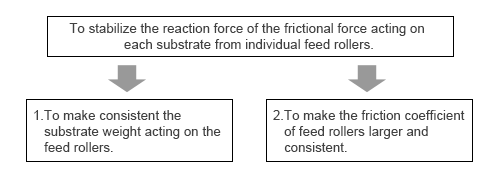#294 Know-how on automation: Transfer -2
General description
One of the considerations for mechanical design for stable transport of glass substrates is equalizing the weight of substrates acting on the feed rollers and increasing and equalizing the coefficient of friction at the contact points between the substrates and individual feed rollers.
Explanation
1)Rules and principles about roller transport
・In the case of roller transport, the principle of transport function is the control of frictional force to move the individual loads being transported.
・In practice, the rotational force of the drive motor for transport is transmitted to the feed rollers. Then, due to the weight of each substrate acting on the feed rollers and the coefficient of friction of feed rollers, the frictional force is produced in the tangential direction. By means of the reaction force to the frictional force, each substrate is transferred. (Fig.1).
・Therefore, as a rule, such mechanical design is required that can cause the frictional force to be generated at the point of contact between individual substrates and feed rollers for ensuring steady transport.
2)Consistency with the principle of roller transport
・For stable transport of substrates based on the roller transport, the following considerations are important.

・To increase the number of feed rollers as a solution in the mechanical structure described in 1 to minimize possible effects of any deformed substrates and equalize the substrate weight acting on individual rollers to the full extent practicable. (Fig.2).
・To install structural members of larger friction coefficient (e.g. rubber) onto the outer circumference of feed rollers as a solution in the mechanical structure described in 2. (Fig.3).
・In this case, the friction members installed onto the outer circumference of feed rollers should be of easy-to-replace design and the replacement members should be commercially available.
・For example, rubber-made O-rings and urethane rubber can be adopted.Rollers included in MISUMI FAparts are also commercially available as standard components.
![[Fig.1]Principle of roller transport](/tt/en/lca/513_01.gif)
![[Fig.2]An example of stabilized weight acting on the rollers](/tt/en/lca/513_02.gif)
![[Fig.3]An example of increased and stabilized friction coefficient of feed rollers](/tt/en/lca/513_03.gif)
- Positioning technology
- Designing and processing
- Sensor Technology
- Automation elements technology
- Clean room technology
- Design hints
- Design tips
- Designing and Machining
- Drive mechanism design
- Hints on designing
- Linear Motion Components
- Locating Technology
- Manufacturing technology
- Motion mechanism design
- Pneumatic Drives
- Production Technology
- Technology Outlook
- General description
- Low-cost automation and materials
- Transfer LCA
- #333 Know-how on automation: Pressurized heating technology - 5: Multilayer pressurized heating process technique
- #332 Know-how on automation: Pressurized heating technology - 4: Points to remember when designing mechanism of pneumatic pressurization method
- #331 Know-how on automation: Pressurized heating technology - 3: Pneumatic pressurization method and pressure profile
- #330 Know-how on automation: Pressurized heating technology - 2: Pressurization method and pressure profile
- #329 Know-how on automation: Pressurized heating technology



